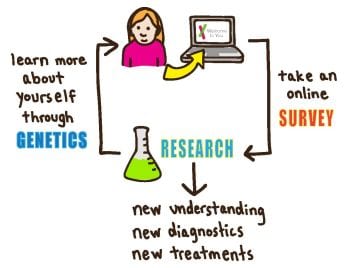
Recently, Todd Sherer, CEO of The Michael J. Fox Foundation (MJFF), Brian Fiske, vice president of research programs at MJFF, and Emily Drabant, 23andMe’s research manager for its Parkinson’s community, sat down and took stock of the recent advances in Parkinson’s research.
Their conversation centered around new understandings of the genetics of Parkinson’s disease that could form the building blocks for research over the next decade.
Learning more about the role genetics plays in Parkinson’s could provide life changing new treatments for people living with the disease. Much of the work to this end is currently focused on a particular mutation in the LRRK2 gene. About one in 10,000 people have this particular mutation – G2019S – which is associated with a 50 percent lifetime risk of Parkinson’s compared to about one percent in the general population. While this association is well established, the role the mutation plays in the development of the disease is less clear. Researchers, however, have made some important breakthroughs offering insight into the possible role that LRRK2 plays in developing the disease, as well as how genetics may interact with environmental factors to cause Parkinson’s.
LRRK2 and Neuroinflammation
Fiske said new data suggests the body’s immune system, particularly the inflammatory response in the brain, may play a key role in the development of Parkinson’s. Inflammation is the body’s response to injury, but the response, particularly an exaggerated immune response, could lead to harmful neuroinflammation. It appears that one component of Parkinson’s is this harmful neuroinflammatory response.
Researchers, supported by MJFF, are studying whether the LRRK2 mutation leads to a more exaggerated inflammatory response. To date, the data are looking very interesting in this direction.
 Todd Sherer, PhD
Todd Sherer, PhD
Sherer said that one high level theory is that if this connection is real this could explain why not everyone with the LRRK2 mutation develops Parkinson’s.
“To activate the immune system response you need some kind of trigger,” he said. “It may take a trigger to interact with the genetics, but no one has tested for this yet.”
LRRK2 And Cellular Pathways
Just as in everyday life we accumulate clutter and waste that eventually has to be thrown out, inside our bodies our daily functions produces trash of sorts that has to be cleared out. Our cells actually have a sort of self-cleaning mechanism called “autophagy” that clears out junk protein and other cellular debris.
Parkinson’s researchers have found that this process is somehow broken in patients with the LRRK2 mutation. Studies are focused on whether decreased autophagy may make cells in the brain more susceptible to Parkinson’s-related cell death. Researchers want to know if this is a cause for the disease or simply an effect from it, said Fiske.
 Brian Fiske, PhD
Brian Fiske, PhD
LRRK2 Clinical Observations
Researchers are comparing individuals who have the LRRK2 mutation and Parkinson’s with people who have developed the disease but don’t have the LRRK2 mutation. These patients who have the disease but don’t have the mutation are also known as “idiopathic” Parkinson’s patients. Researchers found that while the disease in these two types patients appears to be very similar, in some cases the LRRK2 patients have somewhat milder symptoms. For instance, the loss of smell is less pronounced in LRRK2 patients.
According to Fiske work comparing these patients has also highlighted some other intriguing links that researchers would like to explore.. For example, there is an apparent link between LRRK2 and an increased risk for non-skin cancers. This may have to do with a shared genetic background among people of similar ancestry, for instance, instead of some other causal link, but The Michael J. Fox Foundation’s LRRK2 Cohort Consortium is looking into this connection.
Other Genetic Factors for Parkinson’s
When exploring the genetics underlying the disease, researchers are still trying to understand why the LRRK2 mutation sometimes doesn’t lead to development of the disease. Scientists also want to know why the age at which a person develops Parkinson’s is so variable, said Sherer. What is clear is that there are other genetic and environmental factors involved.
 Emily Drabant, PhD
Emily Drabant, PhD
And while there is a lot of focus on the LRRK2 mutation, other genetic factors are also involved. Last year 23andMe found two new genetic associations with the disease and more recently found a genetic variant, SGK1, that is potentially protective against the disease. Other genetic mutations associated with the disease include one protein primarily found in brain tissue called alpha-synuclein, which is encoded by the SNCA gene. Researchers have found that alpha-synuclein accumulates and clumps together in the brain of Parkinson’s patients. There currently is a clinical trial for a drug that specifically targets these clumps of alpha-synuclein as a way to treat Parkinson’s patients.
There are other genetic variants that are also being looked at, and there is a much broader effort to do a sort of “mega” meta-analysis that would develop a master list of common genetic variants associated with the disease. It’s believed that together these genetic variants account for about a quarter of all Parkinson’s cases, but most of those genetic associations have yet to be discovered. 23andMe and MJFF are part of this large-scale effort. Some of this work may be helped as the cost of exome sequencing and full genome sequencing continues to drop. Most recently an association with a variant in the VPS35 gene was found through exome sequencing.
“It’s one of the first PD genes found (through exome sequencing) so it represents a technological turning point away from the classic (genome-wide association study) approaches in the past,” said Fiske. “It seems to play roles in pathways involved in transport of proteins around the cell, but we have little understanding yet of how it might lead to Parkinson’s.”
Parkinson’s Indicators
Another thrust of the research is into biomarkers that can be used to track the progression of Parkinson’s and may help in early intervention. It could be that looking at alpha-synuclein or another protein called DJ-1 may offer a good way to track the disease. In the case of alpha-synuclein, it might be that detecting clumps of the protein could offer a good measure. There is also the possibility of piggybacking on a technique developed for brain imaging of Alzheimer’s disease. That method, looking at the beta-amyloid protein, could be copied in some way with Parkinson’s patients.
Researchers are now able to use a brain scan, called the DATSCAN, to measure dopamine in the brain. But while the scan is good for detecting deficits in people in early stages of the disease, those deficits don’t change significantly after a patient has full-blown Parkinson’s, said Fiske. New imaging technologies could be used not just to diagnose the disease and its progression, but also to test the effectiveness of drug treatment.
Finally, while there is a lot of attention focused on treatment, there is also work being done to try to detect Parkinson’s earlier and earlier. Researchers already know that people in Parkinson’s earliest, or “pre-motor” phase, have distinct symptoms, such as loss of smell, sleep problems and constipation. In combination, those symptoms can be a good predictors of Parkinson’s. By identifying those with high risk of developing the disease, it may be easier to target them with new drugs or other therapies to prevent them from ever developing Parkinson’s.
Conclusion
New understandings of the genetics of PD offers much to be hopeful about. Parkinson’s is an extremely complex disease, but researchers are finding more and more pieces in our effort to complete our understanding of this sometimes puzzling disease. We are lucky to have so many resources to help us do that. This update really only scratches the surface of the work being done to find treatment and a cure for Parkinson’s. We hope to follow up with another update on the promising Parkinson’s research later this year.




